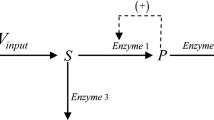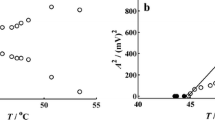Abstract
In this paper, an already published model of the Bray–Liebhafsky reaction was improved by removing the direct autoinhibitory step, which resulted in a new variant of the model with more realistic kinetic scheme than the earlier version. The obtained variant of the model retains all intermediate species (I−, HIO, HIO2 and I2) that were present in the previous model and has one reaction less. Stability analysis of the improved model was performed by stoichiometric network analysis (SNA). By this method, it was shown that improved model can simulate Andronov–Hopf and saddle-node bifurcations. In order to confirm the results of SNA, bifurcation analysis was performed with the initial concentrations of [H2O2]0 as the control parameter. With selected set of rate constants and constant concentrations of external species, two Andronov–Hopf bifurcations were detected at [H2O2]0 = 5.62 × 10−2 M and [H2O2]0 = 10.73 M, while the rate constants ought to be changed for a saddle-node to occur. Bifurcation analysis also showed that the interaction between intermediate species I–, HIO and HIO2 has a crucial impact on the emergence of Andronov–Hopf bifurcation.



Similar content being viewed by others
References
Bray WC (1921) A periodic reaction in homogeneous solution and its relation to catalysis. J Am Chem Soc 43:1262–1267. doi:10.1021/ja01439a007
Bray WC, Liebhafsky HA (1931) Reactions involving hydrogen peroxide, iodine and iodate ion. I: Introduction. J Am Chem Soc 53:38–44. doi:10.1021/ja01352a006
Kolar-Anić Lj, Schmitz G (1992) Mechanism of the Bray–Liebhafsky reaction: effect of the oxidation of iodous acid by hydrogen peroxide. J Chem Soc Faraday Trans 88:2343–2349. doi:10.1039/FT9928802343
Kolar-Anić Lj, Misljenović D, Anić S, Nicolis G (1995) Influence of the reduction of iodate ion by hydrogen peroxide on the model of the Bray–Liebhafsky reaction. React Kinet Catal Lett 54:35–41. doi:10.1007/BF02071178
Kolar-Anić Lj, Mišljenović D, Anić S (1996) Kinetic model for the Bray–Liebhafsky process without the reaction IO3 − + I− + 2H+ ⇄ HIO + HIO2. React Kinet Catal Lett 57:37–42. doi:10.1007/BF02076117
Kolar-Anić Lj, Čupić Ž, Anić S, Schmitz G (1997) Pseudo-steady states in the model of the Bray–Liebhafsky oscillatory reaction. J Chem Soc Faraday Trans 93:2147–2152. doi:10.1039/A608564D
Schmitz G, Kolar-Anić Lj, Anić S, Grozdić T, Vukojević V (2006) Complex and chaotic oscillations in a model for the catalytic hydrogen peroxide decomposition under open reactor conditions. J Phys Chem A 110:10361–10368. doi:10.1021/jp063519b
Schmitz G, Furrow SD (2016) Bray–Liebhafsky and non-catalysed Briggs–Rauscher oscillating reactions. Russ J Phys Chem A 90:271–275. doi:10.1134/S0036024415130178
Vukojević V, Anić S, Kolar-Anić Lj (2000) Investigation of dynamic behavior of the Bray–Liebhafsky reaction in the CSTR. Determination of bifurcation points. J Phys Chem A 104:10731–10739. doi:10.1021/jp001165x
Pejić N, Maksimović J, Ribič D, Kolar-Anić Lj (2009) Dynamic states of the Bray–Liebhafsky reaction when sulfuric acid is the control parameter. Russ J Phys Chem A 83:1490–1495. doi:10.1134/S0036024409090131
Pejić N, Vujković M, Maksimović J, Ivanović A, Anić S, Čupić Ž, Kolar-Anić Lj (2011) Dynamic behavior of the Bray–Liebhafsky oscillatory reaction controlled by sulfuric acid and temperature. Russ J Phys Chem A 85:2310–2316. doi:10.1134/S0036024411130231
Schmitz G (1987) Cinétique de la réaction de Bray. J Chim Phys 84:957–965
Kissimonová K, Valent I, Adamčìková L, Ševčìk P (2001) Numerical simulations of the oxygen production in the oscillating Bray–Liebhafsky reaction. Chem Phys Lett 341:345–350. doi:10.1016/S0009-2614(01)00486-9
Schmitz G, Kolar-Anić Lj, Anić SR, Čupić Ž (2008) Stoichiometric network analysis and associated dimensionless kinetic equations. Application to a model of the Bray–Liebhafsky reaction. J Phys Chem A 112:13452–13457. doi:10.1021/jp8056674
Kolar-Anić Lj, Čupić Ž, Schmitz G, Anić S (2010) Improvement of the stoichiometric network analysis for determination of instability conditions of complex nonlinear reaction systems. Chem Eng Sci 65:3718–3728
Ivanović-Šašić AZ, Marković VM, Anić SR, Kolar-Anić Lj, Čupić ŽD (2011) Structures of chaos in open reaction systems. Phys Chem Chem Phys 13:20162–20171. doi:10.1039/c1cp22496d
Čupic ŽD, Ivanović-Šašić A, Anić S, Stanković B, Maksimović J, Kolar-Anic LjZ, Schmitz G (2013) Tourbillion in the phase space of the Bray–Liebhafsky nonlinear oscillatory reaction and related multiple-time-scale model. MATCH Commun Math Comput Chem 69:805–830
Buchholtz FG, Broecker S (1998) Oscillations of the Bray–Liebhafsky reaction at low flow rates in a continuous flow stirred tank reactor. J Phys Chem A 102:1556–1559. doi:10.1021/jp973362a
Clarke BL (1980) Stability of Complex Reaction Networks. In: Prigogine I, Rice SA (eds) Advances in Chemical Physics. John Wiley & Sons Inc, New York, pp 1–215
Clarke BL (1988) Stoichiometric network analysis. Cell Biophys 12:237–253. doi:10.1007/BF02918360
Čupić Ž, Kolar-Anić Lj (1999) Contraction of the model for the Bray–Liebhafsky oscillatory reaction by eliminating intermediate I2O. J Chem Phys 110:3951–3954. doi:10.1063/1.478274
Čupić Ž, Kolar-Anić Lj (1999) Contraction of the complex models by the stoichiometric network analysis. In: Stojanović BD, Skorokhod VV, Nikolić MV (eds) Advanced science and technology of sintering. Springer, New York, pp 75–79
Schmitz G (1991) Etude du Braylator par la méthode de Clarke. J Chim Phys 88:15–25
Cook GB, Gray P, Knapp DG, Scott SK (1989) Bimolecular routes to cubic autocatalysis. J Phys Chem 93:2749–2755. doi:10.1021/j100344a012
Abbott JP (1977) Numerical continuation methods for nonlinear equations and bifurcation problems. Bull Aust Math Soc 17:307–308
Doedel E, Keller HB, Kernevez JP (1991) Numerical analysis and control of bifurcation problems (I): bifurcation in finite dimensions. Int J Bifurc Chaos 1:493–520
Doedel E, Keller HB, Kernevez JP (1991) Numerical analysis and control of bifurcation problems (II): bIfurcation in infinite dimensions. Int J Bifurc Chaos 1:745–772
Allgower EL, Georg K (2003) Introduction to numerical continuation methods. SIAM
Kuznetsov YA (2004) Elements of applied bifurcation theory. Springer, New York
Krauskopf B, Osinga HM (2007) Numerical continuation methods for dynamical systems—path following and boundary value problems. Springer
Čupić Z, Marković VM, Ivanović A, Kolar-Anic Lj (2011) Modeling of the complex nonlinear processes: Determination of the instability region by the stoichiometric network analysis. In: Brennan CR (ed) Mathematical modelling. Nova Science Publishers Inc., New York, pp 111–178
Clarke BL, Jiang W (1993) Method for deriving Hopf and saddle-node bifurcation hypersurfaces and application to a model of the Belousov–Zhabotinskii system. J Chem Phys 99:4464–4478. doi:10.1063/1.466073
Marković VM, Čupić Ž, Ivanović A, Kolar-Anic Lj (2011) The stability of the extended model of hypothalamic-pituitary-adrenal axis examined by stoichiometric network analysis. Russ J Phys Chem A 85:2327–2335. doi:10.1134/S0036024411130115
Čupić Ž, Marković VM, Ivanović A, Kolar-Anic Lj (2011) Modeling of the complex nonlinear processes: Determination of the instability region by the stoichiometric network analysis. In: Brennan CR (ed) Mathematical Modeling. Nova Science Publishers Inc., New York, pp 111–178
Marković VM, Čupić Ž, Vukojević V, Kolar-Anic Lj (2011) Predictive modeling of the hypothalamic-pituitary-adrenal (HPA) axis response to acute and chronic stress. Endocr J 58:889–904
Maćešić S, Čupić Ž, Kolar-Anic Lj (2012) Model of the nonlinear reaction system with autocatalysis and autoinhibition: stability of dynamic states. Hem Ind 66:637–646. doi:10.2298/HEMIND120210034M
Maćešić S, Čupić Ž, Anić S, Kolar-Anić Lj (2015) Autocatalator as the source of instability in the complex non-linear neuroendocrine model. Int J Non-Linear Mech 73:25–30. doi:10.1016/j.ijnonlinmec.2014.11.008
Maćešić SR, Čupić ŽD, Blagojević SM, Pejić ND, Anić SR, Kolar-Anić Lj (2015) Current rates and reaction rates in the stoichiometric network analysis (SNA). Open Chem 13:591–599. doi:10.1515/chem-2015-0077
Acknowledgments
The present investigations were supported by The Ministry of Education, Science and Technological Development of the Republic of Serbia, under Project 172015 and 45001.
Author information
Authors and Affiliations
Corresponding author
Rights and permissions
About this article
Cite this article
Maćešić, S., Čupić, Ž. & Kolar-Anić, L. Bifurcation analysis of the reduced model of the Bray–Liebhafsky reaction. Reac Kinet Mech Cat 118, 39–55 (2016). https://doi.org/10.1007/s11144-016-1000-2
Received:
Accepted:
Published:
Issue Date:
DOI: https://doi.org/10.1007/s11144-016-1000-2




